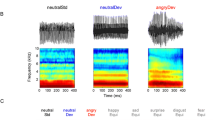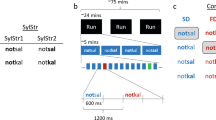Abstract
In this study, we tested the underlying mechanisms of early emotional prosody perception, especially examined whether change detection in oddball paradigm was caused by emotional category and physical properties. Using implicit oddball paradigms, the current study manipulated the cues for detecting deviant stimuli from standards in three conditions: the simultaneous changes in emotional category and physical properties (EP condition), change in emotional category alone (E condition), and change in physical properties alone (P condition). ERP results revealed that physical property change increased brain responses to deviant stimuli in the EP than in the E condition at early stage 90–160 ms, suggesting that physical property change of emotional sounds can also be detected at the early stage. At the later stage 160–260 ms, the simultaneous and respective changes in emotional category and physical properties were reliably detected, and the sum of the brain responses to the corresponding changes in E and P conditions was equal to the brain responses to the simultaneous changes in EP condition. Source analysis further revealed that stimuli-driven regions (inferior parietal lobule), temporal and frontal cortices were activated at early stage, while only frontal cortices for higher cognitive processing were activated at later stage. These findings suggest that emotional prosody changes in physical properties and emotion category are perceived as domain-general change information in emotional prosody perception.




Similar content being viewed by others
References
Amodio DM, Frith CD (2006) Meeting of minds: the medial frontal cortex and social cognition. Nat Rev Neurosci 7:268–277
Bach DR, Grandjean D, Sander D, Herdener M, Strik WK et al (2008) The effect of appraisal level on processing of emotional prosody in meaningless speech. Neuroimage 42:919–927
Boulenger V, Hoen M, Jacquier C, Meunier F (2011) Interplay between acoustic/phonetic and semantic processes during spoken sentence comprehension: an ERP study. Brain Lang 116:51–63
Brosch T, Grandjean D, Sander D, Scherer KR (2008) Behold the voice of wrath: cross-modal modulation of visual attention by anger prosody. Cognition 106:1497–1503
Brosch T, Grandjean D, Sander D, Scherer KR (2009) Cross-modal emotional attention: emotional voices modulate early stages of visual processing. J Cogn Neurosci 21:1670–1679
Buschman TJ, Miller EK (2007) Top-down versus bottom-up control of attention in the prefrontal and posterior parietal cortices. Science 315:1860–1862
Campanella S, Gaspard C, Debatisse D, Bruyer R, Crommelinck M et al (2002) Discrimination of emotional facial expressions in a visual oddball task: an ERP study. Biol Psychol 59:171–186
Chen X, Yang Y (2012) When brain differentiates happy from neutral in prosody? In: Speech prosody, 6th international conference. Shanghai
Dietrich S, Ackermann H, Szameitat DP, Alter K (2006) Psychoacoustic studies on the processing of vocal interjections: how to disentangle lexical and prosodic information? Prog Brain Res 156:295–302
Du Y, He Y, Ross B, Bardouille T, Wu X et al (2011) Human auditory cortex activity shows additive effects of spectral and spatial cues during speech segregation. Cereb Cortex 21:698–707
Ethofer T, Dimitri VDV, Klaus S, Patrik V (2009a) Decoding of emotional information in voice-sensitive cortices. Curr Biol 19:1028–1033
Ethofer T, Kreifelts B, Wiethoff S, Wolf J, Grodd W et al (2009b) Differential influences of emotion, task, and novelty on brain regions underlying the processing of speech melody. J Cogn Neurosci 21:1255–1268
Ethofer T, Bretscher J, Gschwind M, Kreifelts B, Wildgruber D et al (2012) Emotional voice areas: anatomic location, functional properties, and structural connections revealed by combined fMRI/DTI. Cereb Cortex 22:191–200
Frühholz S, Grandjean D (2012) Towards a fronto-temporal neural network for the decoding of angry vocal expressions. NeuroImage 62:1658–1666
Gandour J, Wong D, Dzemidzic M, Lowe M, Tong Y et al (2003) A cross-linguistic fMRI study of perception of intonation and emotion in Chinese. Hum Brain Mapp 18:149–157
Goydke KN, Altenmüller E, Möller J, Münte TF (2004) Changes in emotional tone and instrumental timbre are reflected by the mismatch negativity. Cogn Brain Res 21:351–359
Grandjean D, Sander D, Pourtois G, Schwartz S, Seghier ML et al (2005) The voices of wrath: brain responses to angry prosody in meaningless speech. Nat Neurosci 8:145–146
Grossmann T, Striano T, Friederici AD (2005) Infants’ electric brain responses to emotional prosody. NeuroReport 16:1825–1828
Hoekert M, Bais L, Kahn RS, Aleman A (2008) Time course of the involvement of the right anterior superior temporal gyrus and the right fronto-parietal operculum in emotional prosody perception. PLoS One 3:e2244
Jacquemot C, Pallier C, LeBihan D, Dehaene S, Dupoux E (2003) Phonological grammar shapes the auditory cortex: a functional magnetic resonance imaging study. J Neurosci 23:9541–9546
Jurcak V, Tsuzuki D, Dan I (2007) 10/20, 10/10, and 10/5 systems revisited: their validity as relative head-surface-based positioning systems. Neuroimage 34:1600–1611
Kimura M, Katayama J, Ohira H, Schröger E (2009) Visual mismatch negativity: new evidence from the equiprobable paradigm. Psychophysiology 46:402–409
Korpilahti P, Krause CM, Holopainen I, Lang AH (2001) Early and late mismatch negativity elicited by words and speech-like stimuli in children. Brain Lang 76:332–339
Kujala T, Lepisto T, Nieminen-von WT, Naatanen P, Naatanen R (2005) Neurophysiological evidence for cortical discrimination impairment of prosody in Asperger syndrome. Neurosci Lett 383:260–265
Leitman DI, Wolf DH, Ragland JD, Laukka P, Loughead J et al (2010) “It’s not what you say, but how you say it”: a reciprocal temporo-frontal network for affective prosody. Front Hum Neurosci 4:19
Liu T, Pinheiro AP, Deng G, Nestor PG, McCarley RW et al (2012) Electrophysiological insights into processing nonverbal emotional vocalizations. NeuroReport 23:108
Müller BW, Jüptner M, Jentzen W, Müller SP (2002) Cortical activation to auditory mismatch elicited by frequency deviant and complex novel sounds: a PET study. Neuroimage 17:231–239
Näätänen R, Paavilainena P, Rinne T, Alho K (2007) The mismatch negativity (MMN) in basic research of central auditory processing: a review. Clin Neurophysiol 118:2544–2590
Näätänen R, Kujala T, Winkler IN (2010) Auditory processing that leads to conscious perception: a unique window to central auditory processing opened by the mismatch negativity and related responses. Psychophysiology 48:4–22
Pascual-Marqui RD (2002) Standardized low-resolution brain electromagnetic tomography (sLORETA): technical details. Methods Find Exp Clin Pharmacol 24(Suppl D):5–12
Pinheiro AP, Galdo-Álvarez S, Rauber A, Sampaio A, Niznikiewicz M et al (2011) Abnormal processing of emotional prosody in Williams syndrome: an event-related potentials study. Res Dev Disabil 32:133–147
Sander D, Grandjean D, Pourtois G, Schwartz S, Seghier ML et al (2005) Emotion and attention interactions in social cognition: brain regions involved in processing anger prosody. Neuroimage 28:848–858
Sauter DA, Eimer M (2010) Rapid detection of emotion from human vocalizations. J Cogn Neurosci 22:474–481
Schirmer A, Kotz SA (2006) Beyond the right hemisphere: brain mechanisms mediating vocal emotional processing. Trends Cogn Sci 10:24–30
Schirmer A, Striano T, Friederici AD (2005) Sex differences in the preattentive processing of vocal emotional expressions. Neuroreport 16:635–639
Thierry G, Roberts MV (2007) Event-related potential study of attention capture by affective sounds. Neuroreport 18:245–248
Thönnessen H, Boers F, Dammers J, Chen Y-H, Norra C et al (2010) Early sensory encoding of affective prosody: neuromagnetic tomography of emotional category changes. Neuroimage 50:250–259
Utama NP, Takemoto A, Koike Y, Nakamura K (2009) Phased processing of facial emotion: an ERP study. Neurosci Res 64:30–40
Wildgruber D, Riecker A, Hertrich I, Erb M, Grodd W et al (2005) Identification of emotional intonation evaluated by fMRI. Neuroimage 24:1233–1241
Wildgruber D, Ethofer T, Grandjean D, Kreifelts B (2009) A cerebral network model of speech prosody comprehension. Int J Speech-Lang Pathol 11:277–281
Zevin JD, Yang J, Skipper JI, McCandliss BD (2010) Domain general change detection accounts for “dishabituation” effects in temporal-parietal regions in functional magnetic resonance imaging studies of speech perception. J Neurosci 30:1110–1117
Acknowledgments
This research was supported by the Natural Science Foundation of China (31070989), Open Research Fund of the State Key Laboratory of Cognitive Neuroscience and Learning (CNKOPYB0909). The authors would like to thank Xuhai Chen and Shuzhen Gan for data collection and discussions.
Author information
Authors and Affiliations
Corresponding author
Rights and permissions
About this article
Cite this article
Jiang, A., Yang, J. & Yang, Y. MMN responses during implicit processing of changes in emotional prosody: an ERP study using Chinese pseudo-syllables. Cogn Neurodyn 8, 499–508 (2014). https://doi.org/10.1007/s11571-014-9303-3
Received:
Revised:
Accepted:
Published:
Issue Date:
DOI: https://doi.org/10.1007/s11571-014-9303-3




